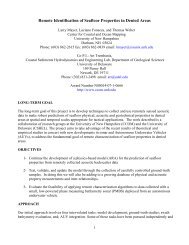EM 2040 Multibeam echo sounder
EM 2040 Multibeam echo sounder
EM 2040 Multibeam echo sounder
Create successful ePaper yourself
Turn your PDF publications into a flip-book with our unique Google optimized e-Paper software.
<strong>EM</strong> <strong>2040</strong><br />
<strong>Multibeam</strong> <strong>echo</strong> <strong>sounder</strong><br />
True wide band high resolution<br />
multibeam <strong>echo</strong> <strong>sounder</strong>
<strong>EM</strong> <strong>2040</strong><br />
Key facts<br />
The <strong>EM</strong> <strong>2040</strong> multibeam <strong>echo</strong><br />
<strong>sounder</strong> is the first system to bring<br />
all the advanced features of deep<br />
water multibeams to the near bottom<br />
sounding environment. Important<br />
deep water system features included<br />
with the <strong>EM</strong> <strong>2040</strong> are:<br />
• Dual swath per ping to allow a<br />
doubling of survey speed<br />
• FM chirp to achieve a much longer<br />
range capability<br />
• Complete roll, pitch and yaw<br />
stabilization<br />
• Nearfield focusing both on<br />
transmit and receive<br />
The <strong>EM</strong> <strong>2040</strong> is modular, allowing<br />
the user to tailor the beamwidths to<br />
the operational requirements, 0.5 by<br />
1 and 1 by 1 degrees. The transmit<br />
fan is divided into three sectors<br />
pinging simultaneously at separate<br />
frequencies. This ensures a very<br />
strong and beneficial dampening<br />
of multibounce interference which<br />
on simpler systems often is seen at<br />
beam angles from 60 degrees and<br />
outwards. The <strong>EM</strong> <strong>2040</strong> has dual<br />
swath capability, allowing a sufficient<br />
sounding density alongtrack at a<br />
reasonable vessel speed, for example<br />
8 knots achieving 100% coverage<br />
with a 0.5 degree transmit fan.<br />
The operating bandwidth available<br />
on the <strong>EM</strong> <strong>2040</strong> is unprecedented,<br />
from 200 to 400 kHz, which is a<br />
full octave, and this is achieved<br />
with the standard transducers. The<br />
operator can thus on the fly choose<br />
the best operating frequency for<br />
the application, 300 kHz for near<br />
bottom, 200 kHz for deeper waters,<br />
and 400 kHz for very high resolution<br />
inspection.<br />
The bandwidth of the <strong>EM</strong> <strong>2040</strong><br />
transducers allows the system to<br />
effectively operate with very short<br />
pulse lengths, i.e. down to 25<br />
microseconds. With 25 microseconds<br />
pulse length the raw range resolution<br />
(cτ/2) will be less than 20 mm.<br />
The <strong>EM</strong> <strong>2040</strong> is well suited for<br />
surveys meeting the IHO-S44 special<br />
order.<br />
The standard depth rating of the<br />
<strong>EM</strong> <strong>2040</strong> subsea parts is 6000 m.<br />
The system is thus fully prepared<br />
for operation on subsea vehicles<br />
such as AUVs or ROVs. All analog<br />
electronics are contained in the<br />
transducers, and communication to the<br />
topside Processing Unit is on standard<br />
Ethernet. For subsea vehicle use the<br />
Processing Unit may be mounted in a<br />
pressure vessel with an inner diameter<br />
as small as 230 mm.<br />
Components<br />
The basic <strong>EM</strong> <strong>2040</strong> has four<br />
units, a transmit transducer, a receive<br />
transducer, a processing unit, and a<br />
workstation. For completeness, data<br />
input from a motion sensor and a<br />
positioning system is required, as is<br />
the sound speed profile of the water<br />
column between the transducers<br />
and the bottom. Sound speed at the<br />
transducer is an optional input.<br />
The <strong>EM</strong> <strong>2040</strong> is delivered with a<br />
mounting plate with factory aligned<br />
guidances. It is recommended that<br />
the mounting plate is built into a steel<br />
casing and protected by a baffle for<br />
multipath reduction. Optionally, the<br />
transducers may be delivered mounted<br />
on a frame together with the motion<br />
sensor and a sound speed sensor,<br />
factory aligned for ease of mounting.<br />
The <strong>EM</strong> <strong>2040</strong> is a modular system,<br />
fully prepared for upgrading to cater<br />
for more demanding applications. The<br />
transmit transducer has an angular<br />
coverage of 200º (±100º) as standard,<br />
allowing a coverage of 5.5 times<br />
water depth when matched with a<br />
single receive transducer. Adding<br />
a second receive transducer allows<br />
surveying to the water surface or up to<br />
10 times water depth on flat bottoms.<br />
The transducers are separate units<br />
with titanium housings.<br />
The transducers are interfaced to<br />
a processing unit via Ethernet, 100<br />
Megabit/s to the transmit transducer<br />
and Gigabit from the receive
<strong>EM</strong> <strong>2040</strong><br />
transducer. The Processing Unit also<br />
supplies power to the transducers.<br />
Operator control, data quality<br />
inspection and data storage is handled<br />
by the hydrographic workstation<br />
running the same SIS software as all<br />
other Kongsberg multibeams.<br />
Operational modes<br />
The <strong>EM</strong> <strong>2040</strong> has a frequency<br />
range of 200-400 kHz. Three<br />
standard modes are available. 300<br />
kHz is used for normal operation,<br />
giving an optimum balance between<br />
high resolution, depth capability<br />
and tolerance of detrimental factors<br />
such as water column sediments.<br />
200 kHz is available for meeting<br />
requirements to operate at the<br />
standard hydrographic single beam<br />
Advanced functions<br />
• Frequency range: 200 to 400 kHz<br />
frequency, but also to achieve the best<br />
depth capability. 400 kHz is provided<br />
for inspection work with the utmost<br />
resolution.<br />
The normally recommended<br />
survey frequency is 300 kHz. At this<br />
frequency the bandwidth used is more<br />
than 75 kHz with three angular sectors<br />
which are run at separate frequencies.<br />
With dual swath six separate<br />
frequencies are used. The minimum<br />
pulselength is 35 microseconds. The<br />
range resolution is then 26 mm. For<br />
deep waters FM chirp is employed<br />
with a bandwidth of 1.7 kHz. This<br />
allows a swath width in the order of<br />
550 m and a depth capability of about<br />
350 m in cold ocean waters.<br />
The 200 kHz frequency mode<br />
has the same CW pulselengths as<br />
the 300 kHz mode. The FM chirp<br />
pulselength is extended compared<br />
to the 300 kHz mode. Normally two<br />
sectors are used per swath. At this<br />
frequency the absorption in the water<br />
is lower than at 300 kHz, resulting<br />
in increased swath width and depth<br />
capability. In cold ocean waters with<br />
FM chirp a swath width of 700 m can<br />
be expected, and approximately 500<br />
m depth capability achieved.<br />
The 400 kHz frequency mode is<br />
intended for high resolution inspection<br />
work. Very short transmit pulses and<br />
wide receiver bandwidth is used. The<br />
operator may choose between one and<br />
three transmit sectors. With a single<br />
RX transducer the coverage can be<br />
up to 120º (±60º), and with dual RX<br />
the coverage can be up to 180º (±90º).<br />
The shortest pulse used is 25 µs. It is<br />
also possible to run dual swath, but<br />
not with the shortest pulse length.<br />
• Dual swath capability, allowing a sufficient sounding density alongtrack<br />
at a reasonable survey speed<br />
• FM chirp allowing much longer range capability<br />
• Complete roll, pitch and yaw stabilization<br />
• Nearfield focusing on both transmit and receive<br />
• Operates with very short pulse lengths, down to 25 microseconds<br />
• The depth rating of the subsea parts is 6000 m<br />
Transducer array (Rx/Tx)<br />
Monitor<br />
HydrographicWork Station (HWS)<br />
Processing Unit (PU)
Technical specifications*<br />
• Frequency range: 200 to 400 kHz<br />
• Max ping rate: 50 Hz<br />
• Swath coverage sector: Up to 140º<br />
(±70º) (single RX) / 200 º (±100º)<br />
(dual RX)<br />
• Sounding patterns:<br />
Equiangular, Equidistant and High<br />
Density<br />
• Roll stabilized beams: Yes, +/-15°<br />
• Pitch stabilized beams: Yes, +/-10°<br />
• Yaw stabilized beams: Yes, +/-10°<br />
0.5 x 1 degrees ** Max depth Max coverage<br />
Operating frequency Cold ocean Fresh water Cold ocean Fresh water<br />
200 kHz 500 m 1070 m 740 m 1520 m<br />
300 kHz 370 m 590 m 580 m 920 m<br />
400 kHz 200 m 270 m 310 m 420 m<br />
1 x 1 degrees ** Max depth Max coverage<br />
Operating frequency Cold ocean Fresh water Cold ocean Fresh water<br />
200 kHz 470 m 1000 m 700 m 1410 m<br />
300 kHz 360 m 560 m 550 m 860 m<br />
400 kHz 180 m 250 m 290 m 390 m<br />
Pulse lengths 200 kHz 300 kHz 400 kHz<br />
CW FM CW FM CW FM<br />
Normal mode 70, 200 and 600 µs 12 ms 70, 200 and 600 µs 6 ms 50 and 100 µs N/A<br />
Single sector mode 35, 70 and 150 µs 1.5 ms 35, 70 and 150 µs 1.5 ms 25 and 50 µs N/A<br />
Max no. of soundings per ping (dual swath) 200 kHz 300 kHz 400 kHz<br />
Single RX 1° RX 800 800 800<br />
Dual RX 1° RX 1600 1600 1600<br />
Physical dimensions (excluding connectors and mounting arrangements)<br />
200 kHz 300 kHz 400 kHz Dimensions Weight<br />
Tx 0.75° 0.5° 0.4° 727 x 150 x 142 mm (L x H x W) 45 kg<br />
Tx 1.5° 1° 0.75° 407 x 150 x 142 mm (L x H x W) 24 kg<br />
Rx 1.5° 1° 0.75° 407 x 136 x 142 mm (L x H x W) 23 kg<br />
Processing Unit (4U 19” rack)*** 447 x 178 x 345 mm (W x H x D) 15 kg<br />
Hydrographic Work Station (4U 19” rack) 427 x 178 x 480 mm (W x H x D) 20 kg<br />
19” Monitor 483 x 444 x 68 mm (W x H x D) 12 kg<br />
* Preliminary specifications. All options may initially not be available<br />
** Beamwidths applicable to 300 kHz<br />
*** More than one Processing Unit may be necessary<br />
Kongsberg Maritime is engaged in continuous development of its products, and reserves the right to alter the<br />
specifications without further notice.<br />
332644 / Rev.F / March 2011<br />
Kongsberg Maritime AS<br />
Strandpromenaden 50<br />
P.O.Box 111<br />
N-3191 Horten,<br />
Norway<br />
Telephone: +47 33023800<br />
Telefax: +47 33044753<br />
www.kongsberg.com<br />
subsea@kongsberg.com


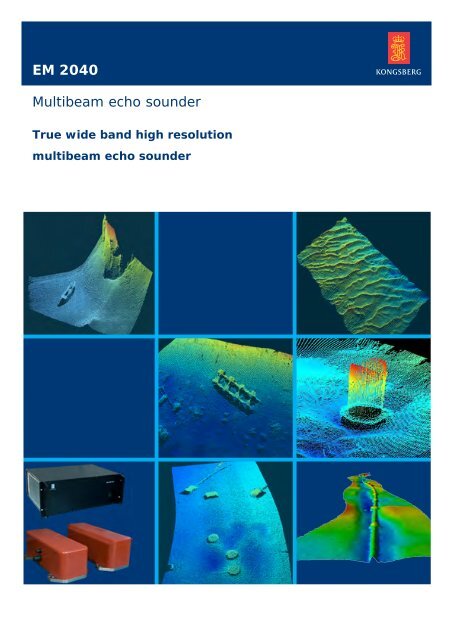
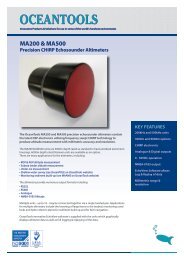

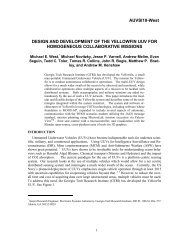
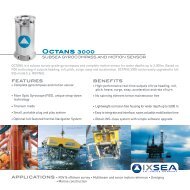
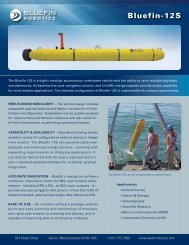
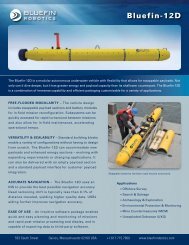


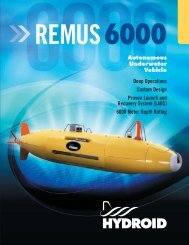


![Sonardyne Wideband Sub-Mini 6 [8270, 8271].pdf - AUVAC](https://img.yumpu.com/44408971/1/190x245/sonardyne-wideband-sub-mini-6-8270-8271pdf-auvac.jpg?quality=85)


